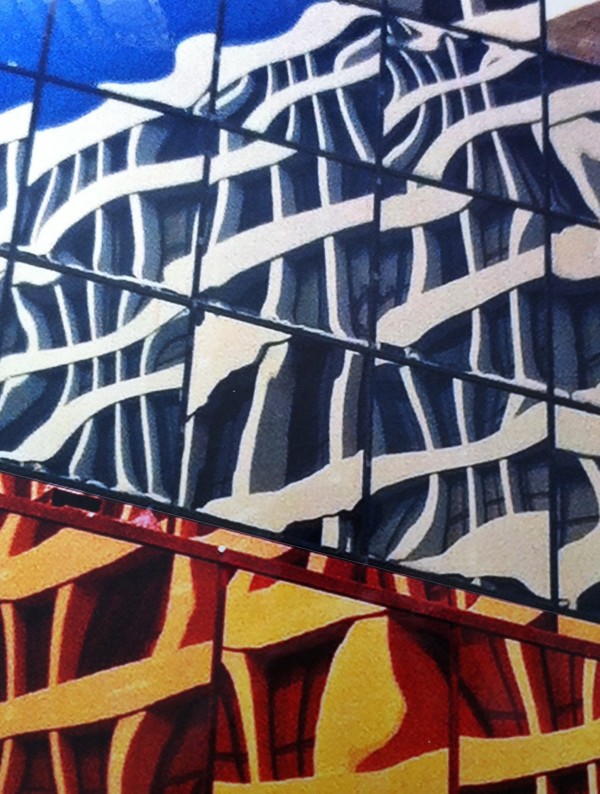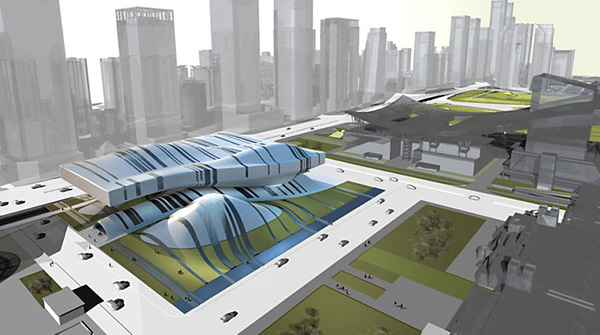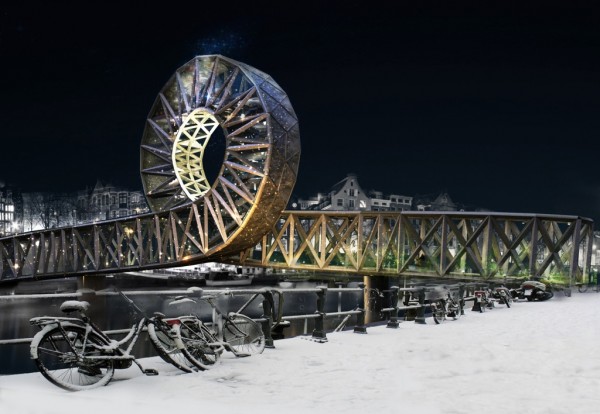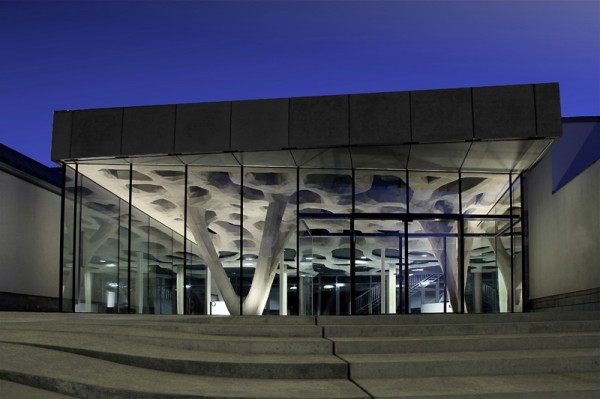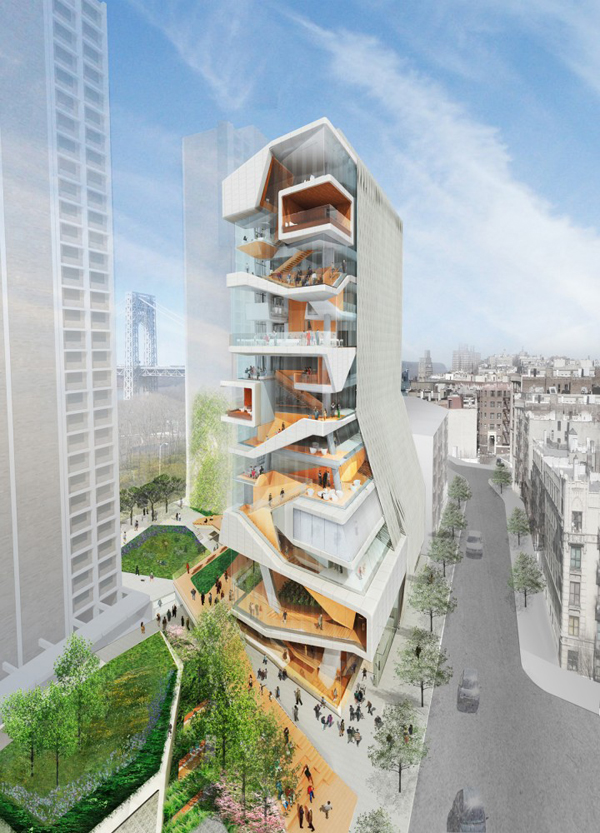In the current proposal for a Contemporary Museum of Art in Buenos Aries, the inception is based on synergetic plays of volumes and interlink-interlacing manifolds of tectonic forms and panels that create a dynamic fluxion of mass, surfaces and lines. The articulations involved relay on formal masses in an arrangement or in a cohesive group that perform more than the sum of its parts. The museum is multi-layered and composed of radiant volumes and pieces which converge in a poly-operational, structural, and sensuous array of tectonics. The effect of multi-generative forms grouped and working together as a performative whole is a diverse set of fluid and crystallized components strategically placed for an outcome of a dynamic structure, which valiancy plays a role in the visual and experiential impact of the viewer. Read the rest of this entry »
Inverted Pyramid Metaphorically Unites Mexico City in Earthscraper/ BNKR
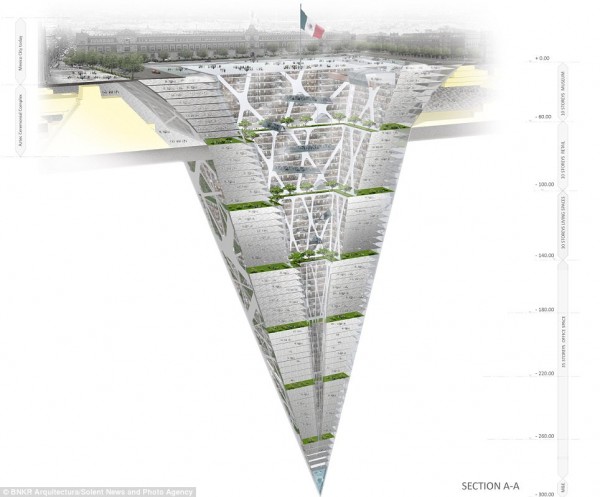
Former eVolo Skyscraper Competition finalist BNKR Arquitectura addresses Mexico City’s urban constraints with an inverted Aztec pyramid, or “Earthscraper,” at the heart of the historic city center. This proposal would conserve today’s historical aesthetic of buildings and public space, endure Mexico City’s growing population, and adhere to city center’s 8-story height restrictions. A 1,000 foot long reversed pyramid is embedded into the ground, where a mini-city is layered 65 stories (300 m) deep. The structure’s glass roof is embedded at the city’s ground level, followed by habitable spaces around the perimeter of the void, allowing natural light to descend to the deepest levels. Read the rest of this entry »
Surface Fabrication Workshop / AA
Is “complexity” anything more than a term to denote the extent of human stupidity, or rather, the limits of our perception?
When the rules governing a scenario cannot be read with ease, the scenario is described as being “complex” – it is difficult to understand; it appears to require some sort of deeper understanding. BUT, as we have seen, the rules are not necessarily any more complicated than the most trivial of scenarios.
So if the rules are still trivially simple (think, for example, of the mathematical operations we use to achieve these forms: +, – , /, *), what is it that is more “complex”? The outcome (of our scripts), of course, contain more surfaces, more lines, more etc etc., but is it really more complex – or are we just too stupid? Read the rest of this entry »
Mesh Grammars Explored in Dome Typology / Dillenburger + Hansmeyer
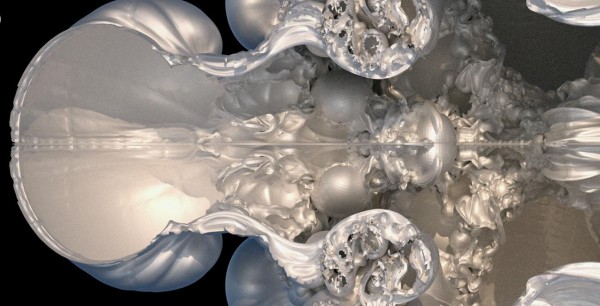
Continuing their investigations on mesh grammars at CAAD, ETH in Zurich, Switzerland, Benjamin Dillenburger and Michael Hansmeyer have explored the creation of a series of domes which consist of a surface being folded over and over. Mesh grammars, as defined by Hansmeyer, is a “process that combines mesh refinement techniques with the logic of shape grammars. Unlike traditional shape grammars, mesh grammars do not consider isolated objects but always view objects as embedded in a network–the mesh.” Read the rest of this entry »
Pop Arch – iPhotography / Carlo Caccavale
Pop Arch is a pop art take on both contemporary and classical architecture. Using a collage medium, the collection mixes “traditional” and reworked iPhotography by splicing photos into sections, manipulating various elements of each image and then rebuilding the photo on metal supports. As Carlo Caccavale explains, “My interest still focuses on witnessing design reality with my iPhone. However, I wanted to give this collection a more playful take and create collage work of arts – inspired by 60’s pop art – and experiment with various subject matters, from the Bernini statues in the Fountain of the Four Rivers and the Pantheon in Rome to Frank Gehry’s latest New York high rise and the terrific modernist buildings in LA.” Read the rest of this entry »
Olympic and Paralympic Shooting Venue / Magma Architecture
Situated in Woolwich on the grounds of the historic Royal Artillery Barracks, the shooting venue of the Olympic and Paralympic Games of 2012 is designed to enhance the festive and celebrative character of the event. It aims to evoke an experience of flow and precision inherent in the shooting sport through the dynamically curving space.
Project description:
Three mobile buildings will accomodate the 10, 25 and 50 m shooting competitions. Shooting is a sport in which the results and progress of the competition are hardly visible to the eye of the spectator. The design of the shooting venue was driven by the desire to evoke an experience of flow and precision inherent in the shooting sport through the dynamically curving space. Read the rest of this entry »
Shenzhen Museum of Contemporary Art / LABORATORIO 543
The Museum Of Contemporary Art & Planning Exhibition proposal is located at Futian District, Shenzhen’s most important central region for administration, business and culture. The building functions as part of Shenzhen’s civic centre, where the City Library, Opera House, Central Bookstore, Youth Activity Hall (YAH) and other civic building have been built. The international competition held in 2007 required The Museum Of Contemporary Art & Planning Exhibition (MOCAPE) to include two independent and yet inter-connected parts: The museum of Contemporary Art (MOCA) and Planning Exhibition (PE). Designed by Rome-based LABORATORIO 543, the proposal is a 90.000 square meter structure that aims to enhance the service of Shenzhen’s new civic center. Read the rest of this entry »
Amstel Loop Iconic Pedestrian Bridge
The aim of the international competition was to design an iconic pedestrian bridge in the heart of Amsterdam The architecture of this new structure would reflect contemporary design tendencies. The winning proposals not only attend to the specific function, but also take into consideration the urban insertion and impact geared towards creating a new architectural symbol for an European capital city.
The bridge designed by Evgeni Leonov Architects is a structure built to span physical obstacles such as a body of water, for the purpose of providing passage over the obstacle. It is designed for pedestrians and cyclists, rather than vehicular traffic. Footbridges complement the landscape and can be used decoratively to visually link two distinct areas or to signal a transaction. Footbridges can be both functional and beautiful works of art and sculpture in there own right as seen in some of the most visited countries around world. Read the rest of this entry »
Viscous Affiliation – New Foyer and Adaption of the Building Academy / soma
Soma’s design creates a new foyer and entrance topography to the Building Academy in Salzburg, and adapts an existing factory hall into a cultural venue. After the conversion, the foyer will serve multiple purposes – as a lobby for the school and as a public space for various cultural events in the adjacent halls, such as presentations, movie screenings, concerts or rehearsals.
The new roof structure creates a consistent and smooth transition between the exterior and the interior of the building. It connects the different functional areas in one fluid space and creates an open and evocative atmosphere. Structural performance, lighting and functional zoning, as well as the creation of an intuitively understandable guidance system correlate in one continuous structure. The widening of the roof geometry from a framed into a freely spreading geometry can be read as a contingent affiliation of the existing spatial characteristics. Read the rest of this entry »
New Columbia University Medical Center / Diller Scofidio + Renfro
Aimed at becoming “a social and academic anchor” of the CUMC campus, the new 14-story high facility will integrate the mixed curriculum and put an emphasis on team-based learning. Designed by Diller Scofidio + Renfro, the “Study Cascade” is a network of social and study spaces distributed across oversized landings along an intricate 14-story stair. Read the rest of this entry »



